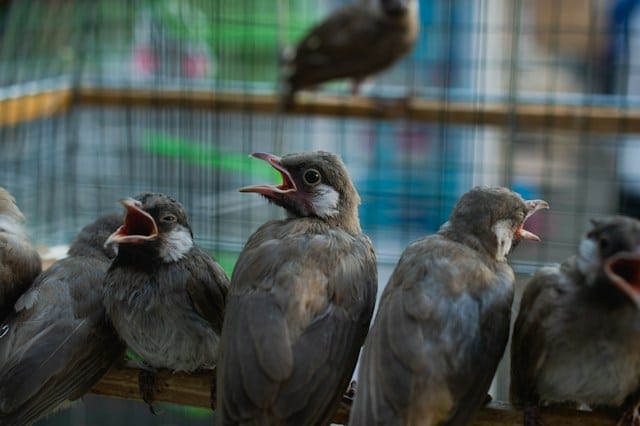What Are the Steps for Safely Introducing a New Pet Bird to Your Flock?

You’ve decided to extend your feathered family, and a new pet bird is about to make its grand entry into your home. But wait, how do you introduce this newcomer to the existing flock without creating a flap? After all, you want your avian crew to live harmoniously without causing a ruffle in their feathers.
In this article, we’ll guide you through the steps required for a safe and smooth introduction. We’ll delve into the importance of quarantine, the rules of gradual introduction, the role of neutral territory, and the need for monitoring interactions. So, let’s begin this journey of amalgamating the old with the new, ensuring peace and calm in your feathery world.
Also to discover : Toxic foods for pets
Start With a Quarantine Period
Before your new bird meets your existing flock, you must start with a quarantine period. This step is vital and shouldn’t be skipped, as it allows you to observe the bird for any signs of illness that could potentially spread to the rest of the flock. In addition, the quarantine time provides your new bird with a chance to adjust to a new environment and the sounds of other birds without the stress of direct interaction.
For the quarantine period, keep your new bird in a separate cage in a different room. This period should ideally last about 30 days. During this time, ensure to clean and feed the new bird’s cage last to minimize the risk of carrying potential pathogens to your existing birds.
Also to see : Tips for traveling with your pet
Gradually Introduce the New Bird
Once the quarantine period is over, and the new bird appears healthy and adjusted, it’s time to start the gradual introduction. This phase allows your birds to become accustomed to each other’s presence slowly, reducing the chances of aggressive behavior or territorial disputes.
Start by placing the new bird’s cage near your existing flock’s cages. Allow your birds to observe each other from their respective cages. This arrangement lets them get used to the sight and sounds of each other without any physical contact.
Establish Neutral Territory
After a few days of sight and sound familiarization, you can begin to allow the birds to interact outside of their cages in a neutral territory. A neutral territory is an area where none of your birds have established a sense of ownership or dominance. This could be a play stand or a tabletop that none of your birds have previously claimed.
Start with short, supervised encounters, always ready to intervene if any disputes occur. Gradually increase the time they spend together as they get more comfortable in each other’s presence.
Monitor Interactions Closely
The final step in the introduction process is to monitor interactions closely. Pay attention to how your birds behave around each other. Birds have their own unique personalities and may not always get along immediately. Look out for any signs of aggression or stress, such as puffing up feathers, lunging, or excessive squawking.
If you notice any troubling behavior, go back a step and give your birds more time to adjust to each other. Patience is key in this process. With time and careful monitoring, most birds will eventually accept a new flock member.
Final Word: Patience is Key
Introducing a new pet bird to your existing flock is a process that requires careful planning, strategic implementation, and a lot of patience. Remember to take it slow and keep a close eye on your bird’s behaviors and reactions at every step. With time, love, and a little bit of bird-whispering, you can ensure a smooth integration of your new pet bird into the flock.
Although bird introductions can be stressful for both the owners and the birds, the joy of seeing your expanded flock cohabitating peacefully is definitely worth the effort. Now that you have the roadmap, it’s time to welcome your new feathered friend and enjoy the cheery chirping of a happy, blended flock!
Utilize Positive Reinforcement
As the gradual introduction progresses, another crucial step is to utilize positive reinforcement. Positive reinforcement can significantly help your new bird adjust to its new environment and flock. This approach involves rewarding good behavior to encourage its repetition. In this context, good behavior means any peaceful interaction between the new bird and your existing flock members.
Start by observing your birds during their supervised encounters in the neutral territory. Whenever you see them interacting peacefully, reward them with their favorite treats. Birds are intelligent creatures, and they’ll soon understand that getting along with the newcomers leads to delicious rewards.
Remember to give the treat immediately after the positive behavior. This way, the bird associates the reward with the behavior. An instant reward can be as simple as a favorite fruit, vegetable, or specially formulated bird treat.
Positive reinforcement should be used consistently throughout the introduction process. It’s not just about the initial meetings but also about maintaining harmony in the long term. Make sure to continue rewarding your birds for their peaceful coexistence even after the new bird has been fully accepted into the flock.
Balancing Attention Between the Birds
Once your new pet bird has successfully been introduced to the existing flock and they’re getting along well, it’s essential to focus on balancing attention between the birds. Even after the new bird has been accepted, the risk of jealousy and rivalry remains, especially if one bird feels like it’s getting less attention than the others.
Spending quality time with each bird individually can help mitigate any feelings of jealousy. Ensure that each bird gets the same amount of playtime and attention from you. This balance can be achieved by dedicating specific times of the day for individual interaction.
Also remember to feed and clean the birds at the same time, to maintain a sense of fairness. Distribute treats evenly, and make sure each bird has its own space and toys. These actions will help maintain peace in your expanded flock and ensure each bird feels valued and loved.
Conclusion: Embrace the Joy of an Expanded Flock
Introducing a new pet bird to your existing flock isn’t a task that can be rushed. It requires care, patience, and dedicated attention to detail. From the initial quarantine to the gradual introduction, establishing neutral territory, monitoring interactions, using positive reinforcement, and ensuring balanced attention, each step is crucial for a successful introduction.
However, the effort is worthwhile. Watching your birds interact, play, and live harmoniously in a shared space can bring immense joy and satisfaction. With your carefully planned introduction, your new bird won’t just be an addition to your flock but a valued and loved member of your feathered family.
Remember, every bird has a unique personality and charm that it brings to your flock. With love, patience, and understanding, you can cultivate a harmonious and happy environment for your feathered friends. So go ahead and embrace the joy of an expanded flock, and let your home resonate with the cheerful chatter of a content and peaceful bird tribe.
